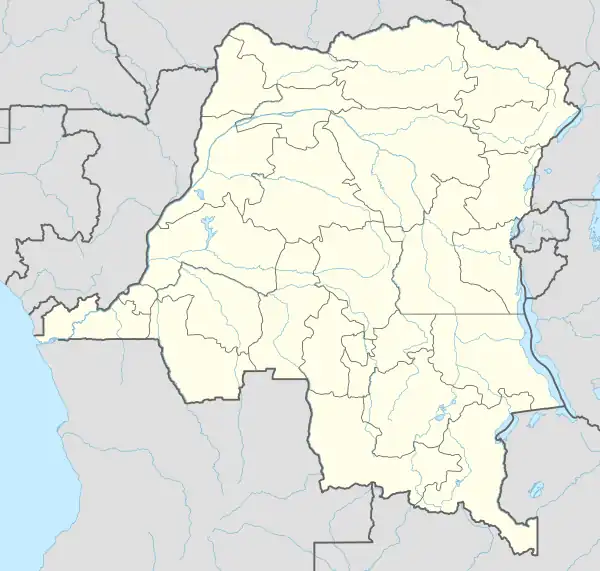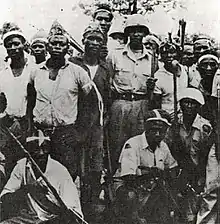Niemba ambush
The Niemba ambush took place on 8 November 1960,[1] when an Irish Army patrol in Congo-Léopoldville was ambushed, the first time the Irish Army was embroiled in battle since the 1922-23 Irish Civil War. Ireland had deployed troops as United Nations Operation in the Congo (ONUC) peacekeepers.
| Niemba ambush | |||||||
|---|---|---|---|---|---|---|---|
| Part of the Congo Crisis | |||||||
 Niemba Niemba ambush (Democratic Republic of the Congo) | |||||||
| |||||||
| Belligerents | |||||||
| Luba militia | |||||||
| Commanders and leaders | |||||||
|
| Unknown | ||||||
| Strength | |||||||
| 11 men | ~100 men | ||||||
| Casualties and losses | |||||||
|
| ||||||
The notoriety of the attack, and the allegations of mutilation and cannibalism that circulated in the Irish popular press in its aftermath, led to the word "baluba" (sometimes spelled "balooba") becoming a synonym for any "untrustworthy and barbaric" person in certain parts of Ireland.[2]
However, the ambush was largely the result of mistaken identity. The Luba tribesmen seem to have mistaken the Irish UN troops for European mercenaries in the service of the State of Katanga, with whom they had recently been in conflict, the Baluba being opposed to Katangese secession. The Irish were part of a UN contingent that was sent to halt the Katangese secession from the Congo.[3]
Background

After the Belgian Congo became independent (as Republic of the Congo) in 1960, a civil war broke out in Katanga, the southern, mineral-rich province of the Congo. A separatist movement was fueled by mining companies who sought to continue their control of the resources in the region, as well as by local and tribal grievances. A local political leader, Moïse Tshombe declared Katanga an independent state.[4]
United Nations peacekeeping troops were invited to help restore order and to end the Katanga secession. Ireland, as well as Sweden and other European nations, supplied troops as part of the UN force. Ireland had applied for membership of the United Nations in 1946, but because of Irish neutrality during World War II this had been vetoed by the Soviet Union until the end of 1955. The Irish Army was therefore anxious to become involved in ONUC and thereby validate Ireland's recent membership, but was unprepared in terms of experience, training, uniforms, arms and vehicles, and was generally reliant on interpreters.
The Luba people or "Baluba" ethnic group did not support the Katangese secession. As a result, they came under attack from pro-Katangese and allied forces. The area around the railway station at Niemba suffered several raids by both Baluba and local Pygmy tribes. On 4 October, several villages were attacked by Katangese gendarmes and European mercenaries and many Baluba were massacred. This left them suspicious of and hostile to any white European troops.[5] Most surrounding villages had been deserted by their inhabitants. Irish troops were sent to the area to secure it and encourage local people to return. A search of the area identified a damaged bridge, which a patrol was sent to, with a mission to effect repairs if possible.[5]
Ambush
On 8 November 1960, an eleven-man section from the Irish Army's 33rd Battalion arrived at the bridge over the Luweyeye River. They were forced to leave their vehicles when they encountered a blockade on the road. While clearing it, they encountered about 100 Luba militiamen armed with bows, poison-tipped arrows, spears and clubs, as well as some guns. While the Irish troops had arrived to protect the Baluba, the militia undoubtedly took them for Katangese mercenaries. Lieutenant Kevin Gleeson, advancing unarmed with his platoon sergeant, Hugh Gaynor, attempted to greet them peacefully, but was hit with a barrage of poison-tipped arrows.[1]
The section leader, Lt. Kevin Gleeson, and Sergeant Gaynor were overtaken and beaten and hacked to death. The surprised Irish soldiers, who had not been deployed in a defensive formation after dismounting from their vehicles, retreated behind trees on either side of the road and opened fire on the tribesmen with their Carl Gustaf submachine guns, Lee–Enfield rifles and Bren light machine guns. The Baluba however advanced on them, and the Irish were cut off from their vehicles. Despite taking heavy losses, the Baluba overran the Irish soldiers and fierce hand-to-hand fighting broke out, during which most of the Irish troops were killed.[1]
Three Irish soldiers managed to escape the initial fighting. One of them, Anthony Browne, reached a nearby village and gave all the money he had to the village women, hoping they would get him help, but was instead mobbed and beaten to death by the village men. His body was recovered two years later. The two surviving soldiers managed to hide and were found by other UN troops the following day.
A total of nine Irish soldiers died: Lt. Kevin Gleeson of Carlow, Sgt. Hugh Gaynor of Blanchardstown,[6] Cpl. Peter Kelly of Templeogue, Cpl. Liam Dougan of Cabra, Pt. Matthew Farrell of Jamestown, Dublin, Tpr. Thomas Fennell of Donnycarney, Tpr. Anthony Browne of Rialto, Pte. Michael McGuinn of Carlow, and Pte. Gerard Killeen of Rathmines. Some 25 Baluba were also killed.
Aftermath
The bodies of the Irish dead were flown to Casement Aerodrome in Baldonnel, where they lay in state. Lt. Kevin Gleeson's coffin was placed on a gun carriage, while those of the rest were placed on army trucks. Following a funeral procession through Dublin, they were buried at Glasnevin Cemetery. For his conduct during the ambush, 19-year-old Trooper Browne was posthumously awarded the Military Medal for Gallantry (the MMG), the Republic of Ireland's highest military award. He was the first recipient of the award. The citation read: "He endeavoured to create an opportunity to allow an injured comrade to escape by firing his Gustaf thereby drawing attention to his own position which he must have been aware would endanger his life. He had a reasonable opportunity to escape because he was not wounded but chose to remain with an injured comrade."[7] At the time it was assumed that Browne had been killed at the scene. It was only later discovered that he had survived for two days before being killed in a separate attack.
A stone commemorating Lt. Gleeson can be found in his hometown of Carlow[8] while a plaque commemorating Sgt. Hugh Gaynor can be found in his hometown of Blanchardstown.[6]
Thomas Kenny, one of the survivors, believes that the real circumstances of Anthony Browne's death were misrepresented by the army, because they wished to have a hero to offer to the public. The wording of the citation implied that Browne had died trying to protect the wounded Kenny, by moving into the open and drawing fire on himself, letting an opportunity to escape pass. In fact he did escape into the forest.[9]
Effects in Ireland
Fionn Rogan argues that the massacre had a corrosive effect in the Republic of Ireland, where there had been strong support for the Congo expedition:
The effect of the Niemba ambush on Irish society’s perception of the army was massive. The attack punctured the swelling pride that was emboldening the nation. The professionalism of our soldiers was called into question, which wasn’t received well in Ireland. It presented a stumbling block to the development of the Irish military and Ireland’s position as an international force. However Ireland managed to regain its composure. Ireland’s position in future UN peacekeeping operations was preserved due to an impressive handling of the siege at Jadotville the following September.[2]
The Baluba has long been associated with acts of cannibalism.[10] Lurid stories circulated in the Irish popular press that the bodies of the victims had been mutilated and that their hearts had been removed to be eaten by the Baluba.[11] As a result the word "baluba" became a synonym in Ireland for an "unruly or wild person".
References
- Cusack, Adrian (10 November 2010). "Athlone resident recalls Niemba ambush horror". Westmeath Independent. Retrieved 27 December 2016.
- Rogan, Fionn (10 January 2014). "Niemba – The Birth of an Army". University Times.
- "Letters from Niemba: Irish troops in the Congo, 1960". historyireland.com. 5 March 2013. Retrieved 27 December 2016.
- Boehme 2005, pp. 2.
- "Letters from Niemba: Irish troops in the Congo, 1960", History Ireland, Issue 6 (Nov/Dec 2010), Volume 18.
- "Plaque for Dublin soldier who died in the Congo". RTE.ie. 3 February 2018. Retrieved 3 February 2018.
- Clark, John, Gallantry Medals & Decorations of the World, Pen and Sword, 200, p.54.
- "RTÉ Television - War Stories". RTÉ.ie.
- "Congo massacre survivor: Army must tell real story", Irish Independent, 5, November, 2000.
- Michael B. Lentakis, Ethiopia: A View from Within, Janus, 2005, p.306.
- Prendeville, Tom, "Congo Hell Cannibals Killed My Comrades ..And Ate Every One; Irish Soldier Who Survived Jungle Horror...And Still Waits For Medal", 30 May 2004, The People, London.